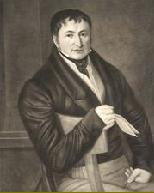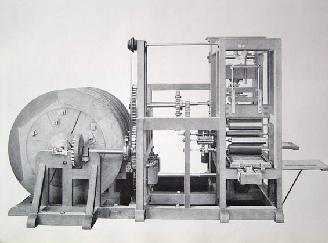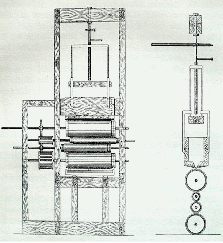 |
 |
 |
 |
 |
 |
 |
 |
 |
 |
 |
 |
 |
 |
 |
 |
 |
|
|
|
|
|
|
|
|
|
|
|
|
|
|
|
|
|
|
|
|
|
|
|
|
A review of the extraordinary contribution made by Johann Friedrich Gottlob Koenig - still relatively under-valued in Western countries - whose mechanical genius and high standards fortold a revolution in typography and opened the pathway for mass production of printed matter. The majority of information was obtained from an impartial article (rare for the times); 'Men of Invention and Industry, (Chapter 6) Frederick Koenig: Inventor of the Steam Printing Machine' by Scot, Samuel Smiles, with some additional material and corrections. This was augmented with technical details from a booklet, 'The First Printing Machines, constructed in London up to the year 1818' by Koenig's trusted partner, Andreas Friedrich Bauer, produced for the Great Exhibition, held at the Crystal Palace, London, 1851, in lieu of their attendance.
|
|
|
|
|
|
|
|
|
|
Earliest invention: The 'Suhl' [or 'Suhler'] powered platen press
|
|
|
|
|
|
|
|
|
__Koenig was born 17th April, 1774 at Eisleben, in Saxony, Germany, the son of a farmer. After a good education, he was bound apprentice for five years to Breitkopf and Hartel, of Leipzig, as compositor/printer. After four years and three months he was released from his engagement, because of his exceptional ability. He then worked for a number of other printers, as was customary in that country then, acquiring additional skills, before returning to his original employer. Shortly thereafter, he enrolled himself for a year at Leipzig University. According to Koenig's own colourful account, in 1802 he first began to devise ways and means for improving the art of printing by eliminating some of the "horse-work".
|
|
|
 |
|
|
|
|
|
|
Friederick Koenig 1774-1833
|
|
|
|
|
|
|
|
__His first effort, produced in 1803-04, known as the Suhl(er) press, was basically a powered, wooden hand press with moveable carriage, reciprocating platen, self-opening frisket and self-inking 'cylinders' (wooden rollers wrapped with layers of felt and covered with leather). Whether an actual machine was constructed is not known but it was considered too complicated and costly by German printers; war with France was imminent also which would have discouraged speculation. He resolved then to try his luck abroad. In the meantime the Russian Government, having heard of his inventive ability, offered him the position to organise the State printing office at St. Petersburg. The invitation was accepted and he proceeded there in 1806. But 'officialdom' so discouraged him that he resolved, 'after two lost years of fruitless applications in Germany and Russia' to try his luck in England.
|
|
|
|
|
 |
|
|
|
 |
|
|
|
|
|
|
|
|
Scale model (1:2) of Koenig's wooden Suhl(er) press, devised in Germany 1803-04. The large drum at left may have propelled the stop-start bed carriage by means of a cam race and possibly acted as a fly-wheel would for storing inertia. Right: The novel inking system. Note the single forme roller, simple oscillator roller gearing and prototype ink reservoir (ink pressed out of ink-box by screw pressure).
|
|
|
|
|
|
|
|
|
|
__After arriving in London, Koenig had difficulty finding printers interested in his ideas, eventually however, he was introduced to Thomas Bensley, a book printer of Bolt Court, Fleet Street. Bensley was receptive to the ideas of Koenig and, on the 30th November, 1807 they put their signatures to a business agreement.
|
|
|
|
|
|
|
__Koenig's original plan was confined to his 'improved' powered hand press, where the operation of applying the ink to the type was performed by rollers connected to the motions of the bed, thereby saving the labour of one person, known as the dabber or beater. With the continuing refinement, versatility and availability of the steam engine - particularly in England, it was decided this rotary motion could be best used to power the machine. Whilst Koenig was thus engaged, he was joined by fellow countryman and good friend, Andreas F. Bauer (1783-1860), a clever mechanician (some sources say watchmaker) and eventual partner. Together, these two proceeded to pool their ideas, and to construct the first actual printing machine powered by steam.
|
|
|
|
|
|
|
 |
|
|
|
__A patent was taken out 29th March, 1810. The specifications stated in part: 'A machine with impression by a platen, in which the printing was produced by two plain plates just like in the common press.' The machine was finally set to work in April, 1811 and printed off 3,000 copies of sheet (H) of the Annual Register for 1810, 'Principal Occur-rences.' This was, in Koenig's words 'no doubt, the first part of a book ever printed with a machine'. The press is said to have worked at the rate of 400 impressions per hour, a modest improvement on the hand press; he continued to make improve-ments until he finally realized that it could advance no further technically. [Somewhat incorrectly it seems, as his methods were used several years later by other like-minded press builders, culminating in the successful Bed & Platen powered book printing mach-ines of Treadwell, Adams, Hoe and others - see index].
|
|
|
|
|
|
|
|
 |
|
|
|
|
|
|
These diagrams, first published in Bauer's 1851 publication, show the later cast-iron version, built in England. Note the large wooden drum has been dispensed with.
|
|
|
|
|
|
|
|
|




